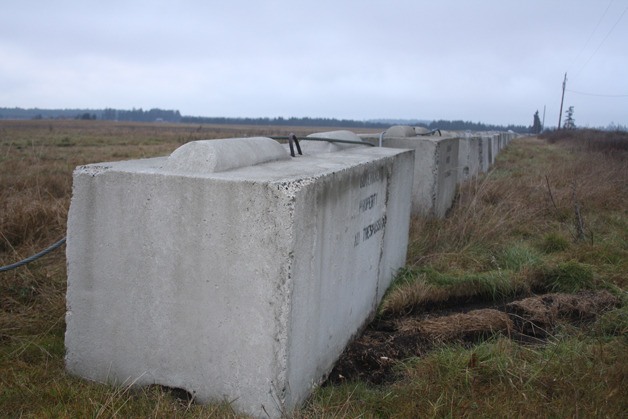A state agency has reversed its determination about cement blocks placed at Outlying Field Coupeville saying that they are, in fact, an “adverse effect” to the historic landscape of Ebey’s Landing National Historic Reserve.
More than 1,000 cement barriers were installed earlier this month at the Navy’s outlying field, part of Naval Air Station Whidbey Island, where they conduct touch-and-go operations for the EA-6B Prowler and the new EA-18G Growler. The Navy also plans to add fencing at the entryways.
While the state’s Department of Archaeology and Historic Preservation initially issued a “no adverse effect” determination in September, the office retracted the statement last week “due to new information about the project.”
Allyson Brooks, the state historic preservation officer, said after receiving questions from the public, the project was reviewed.
It was found that while the Navy addressed archaeological concerns, they did not address effects the blocks may have on the historical nature of the area. Under the National Historic Preservation Act, or NHPA, projects involving national parks like Ebey’s Reserve must be reviewed by the state Historic Preservation Officer.
“Clearly the Navy consulted the state archaeologist, but did not consider the effects to the historic landscape,” Brooks said.
Whether or not the blocks will be permanent is also a concern for Brooks.
In correspondence to the state historic preservation officer’s office, Kendall Campbell, archaeologist and cultural resources program manager, said that the blocks are a temporary fix to OLF’s security issues.
“Ebey’s Reserve is adjacent to the northern boundary of OLF Coupeville,” Campbell said. “Since the concrete blocks are short — less than 3 feet high — and easily removed, they do not permanently impact the viewshed of Ebey’s Reserve or historic properties, such as a solid fence for example. The blocks are a temporary solution to a long identified security risk at OLF.”
Any more permanent solution to the airfield’s security issues would be treated as a separate undertaking, Campbell said, requiring a “more robust NEPA” process.
Brooks said that a “no adverse effect” determination was sufficient for this type of barrier for up to five years. But when the Navy was unable to furnish a solid time frame for the blocks, she factored this into her decision to reverse the determination.
“For a period of longer than five years we contend that the visual impacts to the historic Ebey’s landscape will alter the characteristics that make the area nationally significant,” Brooks wrote in her determination letter.
Since Brooks has found the project to have an “adverse effect,” the Navy now moves into mitigation with the state agency where additional organizations will be consulted to determine a solution. A Memorandum of Agreement will need to be drafted with the consultation of all affected parties.
“The base’s cultural resources program manager continues to consult with the state on these projects, as well as with the National Park Service and the Ebey’s Landing National Historical Reserve,” said Mike Welding, public affairs officer for the base.
Citizens of Ebey’s Reserve, or COER, is calling for an immediate removal of the cement blocks at OLF.
“The shame is that none of this needed to occur, if only the Navy had followed the rules established to protect the public,” concluded Michael Monson, chair of COER.



